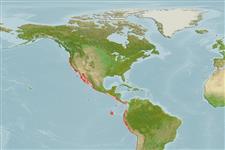Elasmobranchi (squali e razze) (sharks and rays) >
Carcharhiniformes (Ground sharks) >
Triakidae (Houndsharks) > Triakinae
Etymology: Mustelus: Latin for weasel, an ancient name for sharks, possibly referring to the pointed snouts, swift movements and/or rapacious feeding behavior of smaller predatory sharks [strictly not tautonymous with Squalus mustelus Linnaeus 1758 since type was designated by the ICZN]. (See ETYFish); henlei: In honor of Friedrich Gustav Jacob Henle (1807-1885), German physician, pathologist and anatomist, who, along with Johann Müller, produced the first authoritative work on sharks (1839-1841). (See ETYFish).
More on author: Gill.
Environment: milieu / climate zone / depth range / distribution range
Ecologia
marino demersale; distribuzione batimetrica 0 - 281 m (Ref. 96339). Subtropical; 48°N - 18°S, 126°W - 72°W (Ref. 55310)
Eastern Pacific: northern California, USA to the Gulf of California; Ecuador and Peru.
Length at first maturity / Size / Peso / Age
Maturity: Lm 57.0, range 51 - 63 cm
Max length : 100.0 cm TL maschio/sesso non determinato; (Ref. 31395); Età massima riportata: 13 anni (Ref. 6098)
Adults are found on the continental shelves from the intertidal region to at least 200 m depth. They feed on crabs, ghost shrimps, mantis shrimps, isopods, squids, polychaete worms, tunicates and small bony fishes. Viviparous (with a yolk-sac placenta), with 3 to 5 young in a litter. Size at birth between 19 and 21 cm. Readily kept in captivity. Utilized for human consumption. Marketed fresh, smoked and frozen (Ref. 9987).
Viviparous with a yolk-sac placenta; with 3 to 5 young in a litter. Size at birth ranges from 19-21 cm (Ref. 244). Distinct pairing with embrace (Ref. 205). Polyandry is a common life history strategy among the elasmobranchs and for M. henlei, the occurrence and frequency of polyandric behavior may vary depending on location and density of breeding individuals (Ref. 95902).
Compagno, L.J.V., 1984. FAO Species Catalogue. Vol. 4. Sharks of the world. An annotated and illustrated catalogue of shark species known to date. Part 2 - Carcharhiniformes. FAO Fish. Synop. 125(4/2):251-655. Rome: FAO. (Ref. 244)
IUCN Red List Status (Ref. 130435)
Threat to humans
Harmless
Human uses
Pesca: elevato interesse commerciale; Pesce da pesca sportiva: si
Informazioni ulteriori
BibliografiaAcquacolturaProfilo di acquacolturaVarietàGeneticaElectrophoresesEreditarietàMalattieElaborazioneNutrientsMass conversion
CollaboratoriImmaginiStamps, Coins Misc.SuoniCiguateraVelocitàModalità di nuotoArea branchialeOtolithsCervelliVista
Strumenti
Special reports
Download XML
Fonti Internet
Estimates based on models
Preferred temperature (Ref.
123201): 9.7 - 23.5, mean 15.4 °C (based on 100 cells).
Phylogenetic diversity index (Ref.
82804): PD
50 = 0.5000 [Uniqueness, from 0.5 = low to 2.0 = high].
Bayesian length-weight: a=0.00224 (0.00105 - 0.00478), b=3.14 (2.97 - 3.31), in cm total length, based on LWR estimates for this Genus-body shape (Ref.
93245).
Trophic level (Ref.
69278): 3.6 ±0.4 se; based on diet studies.
Resilienza (Ref.
120179): Basso, tempo minimo di raddoppiamento della popolazione 4.5 - 14 anni (rm=0.127; K=0.26; tm=2-6; tmax=15; Fec=3).
Fishing Vulnerability (Ref.
59153): High vulnerability (58 of 100).
Climate Vulnerability (Ref.
125649): High vulnerability (61 of 100).
Nutrients (Ref.
124155): Calcium = 20.8 [5.7, 103.5] mg/100g; Iron = 0.509 [0.159, 1.911] mg/100g; Protein = 21.7 [19.4, 24.0] %; Omega3 = 0.147 [0.061, 0.347] g/100g; Selenium = 42.3 [12.2, 148.1] μg/100g; VitaminA = 6.83 [2.38, 18.97] μg/100g; Zinc = 0.616 [0.272, 1.231] mg/100g (wet weight);
